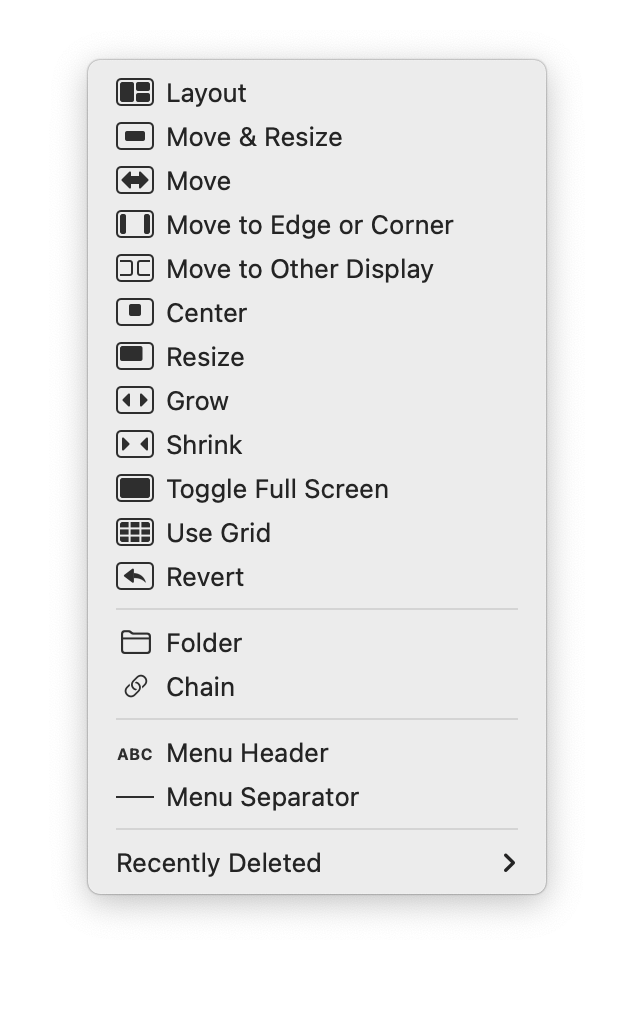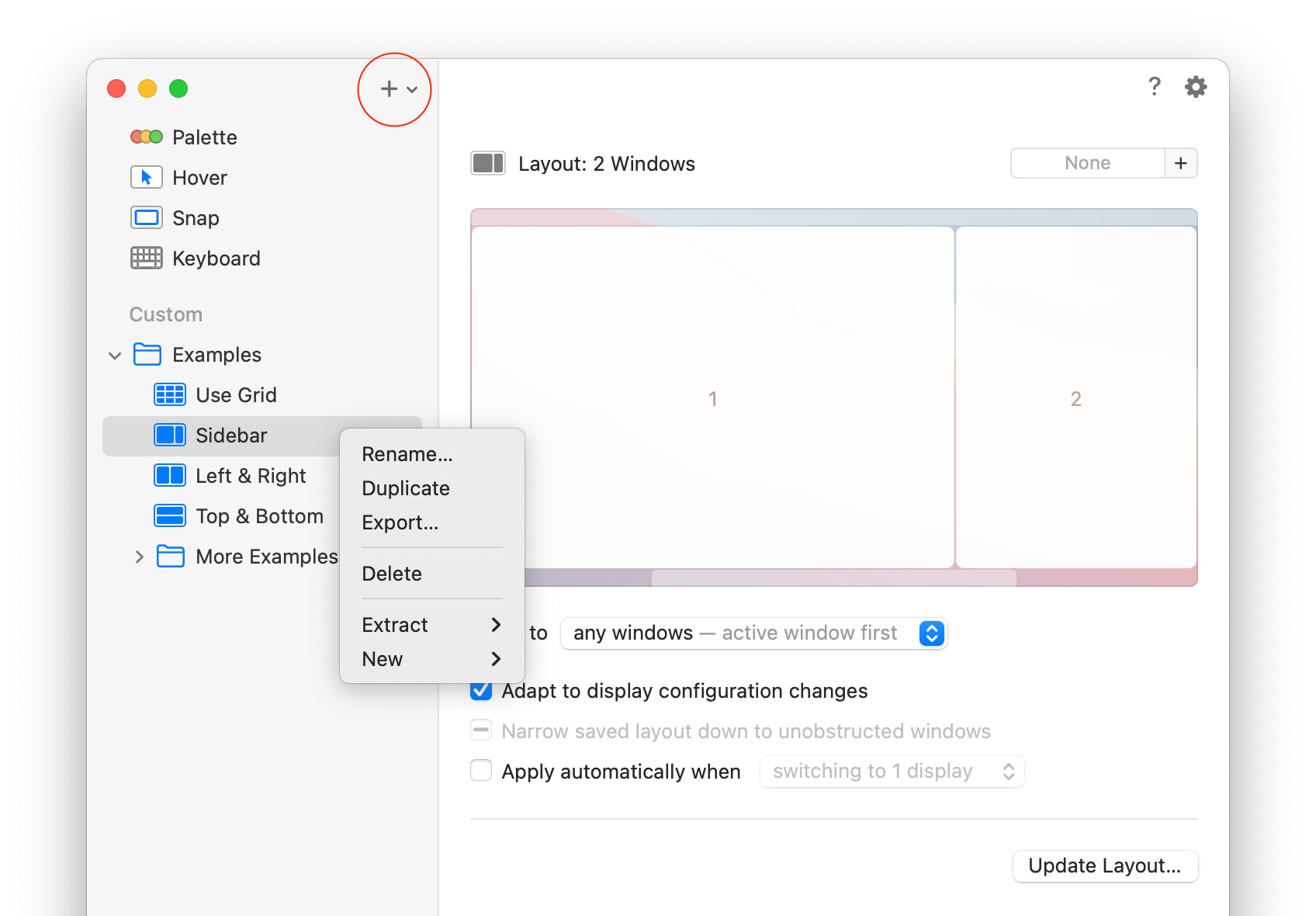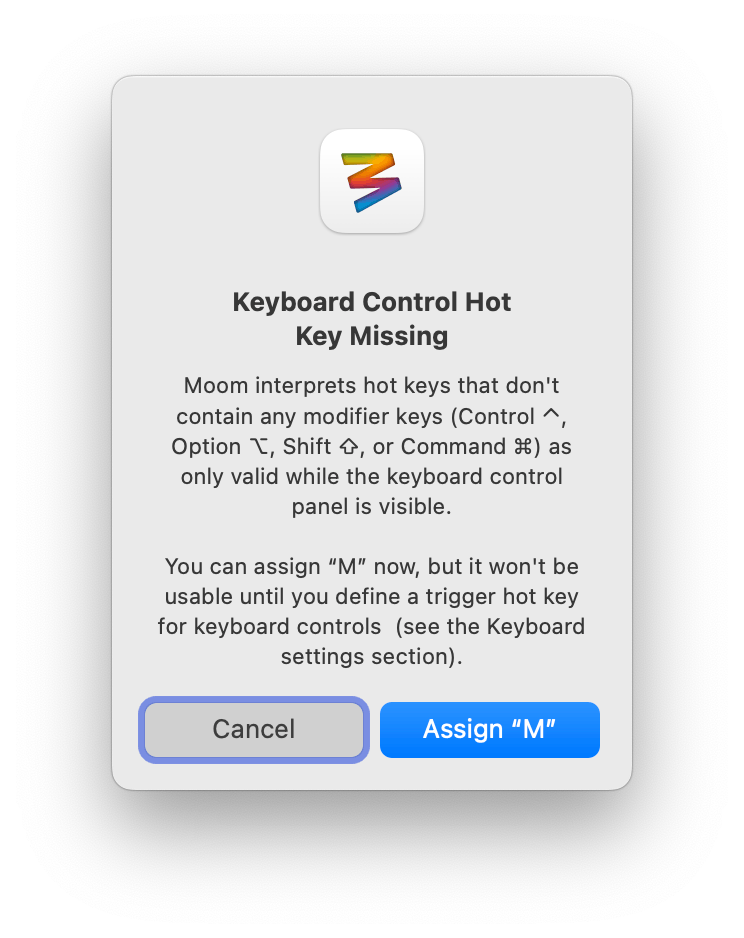
While Moom's standard Hover, Keyboard, Palette, and Snap features may be sufficient for many users, the ability to create custom actions lets you expand Moom's functionality beyond—way beyond—what these built-in features offer. So while you don't have to use custom actions, once you understand what you can do with them, you may find that you want to use custom actions to turn Moom into the perfect tool for your needs.
A custom action is a Moom action (as seen at right), or a series of actions, that you customize and (optionally) assign a keyboard shortcut with which to activate the action. Custom actions can be used in the Palette, as well as in Keyboard and Snap.
Custom actions can have either single-key or multi-key keyboard shortcuts. Multi-key shortcuts (⇧⌘⌥7, for example) are always global, so they'll work from anywhere at any time. Single-key shortcuts only work when Moom's keyboard controller is visible—you wouldn't want A to run a Moom action every time you typed it! See the section below on Hot Keys for more details.
Before discussing Moom's custom actions, however, it's important to understand how to use the Custom section of Moom's settings, as it applies to everything you'll do with custom actions. After reading this section, you can jump right into the chapter covering every single custom action in detail..
Interface
Most of Moom's settings window is related to working with custom actions:

As seen in the above screenshot, you interact with custom actions through the drop-down menu at the top of the window (in the red callout circle), the contextual menu for one or more actions, and the area on the right where you can customize each action.
In the following topics, actions that exist on the contextual menu also exist on Moom's main menu, which is visible by default when Moom's settings are open. (You can change this behavior in Moom's general settings.) The main menu variants won't be listed, but know that any time you read "contextual menu" you can also find the same action on the main menu bar.
Add a custom action
To add a new custom action, you can either click on the "+" sign at the top of the window, or right-click anywhere in the left side of the window. This will reveal the menu seen at the top of this section; pick an action and it's added to the list.
If you right-click on an empty section of the sidebar, you'll see the New Custom Action pop-up menu; if you right-click on an entry in the list, then you'll see the item's contextual menu, and the custom actions will appear on a submenu when you highlight New in the contextual menu.
You can also duplicate an existing action for use as a starting point in setting up a new action. You'll find Duplicate in the contextual menu, or as in Finder, you can hold down the ⌥ key and drag an existing entry in the list to create a copy.
Remove a custom action
To remove a custom action, either right-click on it and select Delete, or drag it out of the list and outside the bounds of the Moom settings window, then drop it.
You can restore recently-deleted actions using either the "+" button, the contextual menu, or the File menu. Activate the "new" menu via any of these methods, and you'll see a Recently Deleted entry at the bottom of the menu. Select the action to restore to retrieve it. Note that this isn't a permanent "undo" feature, as it only tracks the last 10 deleted actions, and only until you quit Moom.
Rename a custom action
To rename an action—they can all be renamed now—use one of these two methods: Either double-click on the action, or right-click on the action and select Rename. If you add a Folder or Menu Header custom action, they will be active and ready to rename when added.
If you name your custom action with a leading dot (.), it won't appear in any of Moom's menus. This can be a useful way to declutter the menu for custom actions you'll only use via the keyboard or drag zones, etc.—anything that doesn't require you to pick the custom action from a menu.
Working with the list
The list of custom actions behaves much like any other list in macOS: You can rearrange items by dragging, and you can select more than one action using the ⇧ and/or ⌃ keys, much as you do in Finder. You can then duplicate, delete, rearrange, etc. multiple actions at once. Note that you can only use multi-select actions at the same level: If you're selecting within a folder, you can only multi-select the actions within that folder.
The contextual menu is both contextual and powerful, so use it. Select more than one action and right-click, and can be used to easily move the selected items into a new folder. Or select a bunch of separate Move & Resize actions, and the contextual menu will offer , which will turn them into a new saved layout. (More on that in the Custom Actions chapter, which covers the Layout action.) When in doubt, check the contextual menu!
Hot Keys
Every custom action in Moom (except for menu headers and menu separators) can optionally be assigned hot keys (keyboard shortcuts) to activate the action. There are two distinct types of hot keys: Global, which work in any application, and restricted, which only work when Moom's Keyboard overlay is active.
Depending on what (if any) keyboard shortcut you've assigned, you'll see one of three things in a custom action's header area:

The first image is the default (no shortcut); just click in the box labeled "None" to assign one. If you assign a multi-key shortcut (second image), those are global shortcuts. If you assign a single-key shortcut (third image), those are restricted shortcuts.
Why should you use restricted shortcuts? Because you then only need to remember one shortcut—the one to activate Keyboard mode. In Keyboard, you can optionally see a cheat sheet listing all your single-key shortcuts. You can also set a relatively simple shortcut—as you'll have just the one—for Keyboard mode, making it easy to use.
If you haven't enabled Keyboard mode before creating a restricted shortcut, you'll see this dialog:

If you see the above dialog, click the Keyboard entry in the side bar, and assign a shortcut to the Control active window key hot key setting.
Sharing
Moom includes a few ways to share custom actions with other Macs, either on your own network or not. For Macs on your own network, there are two very easy ways to share custom actions:
- If you use Universal Control to share your mouse and keyboard between connected Macs, you can drag-and-drop a selection of custom actions from Moom's Settings window on one Mac into Moom's Settings window on another Mac.
- Again with Macs on the same network, macOS' Universal Clipboard means you can copy a selection of custom actions on one Mac, and then paste them into Moom's Settings window on another Mac.
If you want to post one or more custom actions, or share them with friends, you can do that using Moom's export feature. Select one ore more things to export, then use → to save them. Post or send that file, and then others can use → to import the actions.
While Moom doesn't yet support syncing, you can use any of the above methods to easily copy an entire set of actions to another Mac. Just select all your actions, then use your method of choice to drag, paste, or import them on the other Mac.

